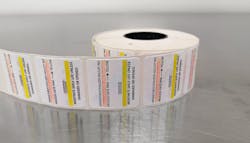Color-coded standard needed for H2O2 sterilization indicator strips
Earlier this year numerous healthcare facilities alerted the Food and Drug Administration (FDA) of the potential for healthcare personnel to misinterpret colored hydrogen peroxide chemical indicator strips that are used to validate vapor sterilization of medical devices. Misinterpretation creates the potential for patient harm because currently there is no standard indicator color to show if a device has been sterilized and safe for use. This concern led the FDA to issue a letter to healthcare providers on May 7, alerting them to this problem.
According to the FDA’s letter, during the COVID-19 pandemic, “Reprocessing staff may be using sterilization systems for the first time or concurrently using sterilization systems from different manufacturers. If staff assumes that all manufacturers use the same color code to validate sterilization, they may mistakenly release contaminated devices for reuse.”1
The FDA’s letter also points out that they are currently working with the manufacturers of vapor sterilization indicator strips to improve the products’ labeling “and explore standardization for colors used to indicate sterilization.”2 Currently, manufacturers of indicator strips have been left to come up with their own color schemes to indicate sterility. What is even more confusing is that the manufacturers’ various colors have been validated for the same hydrogen peroxide sterilization cycle conditions and approved for use by the FDA.
This lack of a standard color code puts healthcare personnel in the untenable position of not being able to tell immediately whether a device has been sterilized and is safe for use with patients. If a patient infection or fatality can be definitively linked to the incorrect interpretation of an indicator label color by healthcare personnel, the healthcare facility and the label manufacturer potentially will face litigation with a large damage claim.
To eliminate the current risk of patient harm caused by the lack of a standard color-coding scheme, one of three solutions must be adopted and implemented immediately:
1. The FDA issues a requirement for manufacturers of indicator strips to adopt a single, industry-wide color-coding scheme.
2. If the FDA doesn’t issue a requirement, then the manufacturers themselves must voluntarily agree to a single, industry-wide color-coding scheme.
3. Unless – and until – one of the first two options are implemented, healthcare facilities can choose to stop using hydrogen peroxide as a sterilization media or, they must follow the recommendations in the FDA’s letter:
a. Review the manufacturer’s instructions for the particular indicator bar or card being used and know the significance of the indicator colors.
b. Enhance staff training on the indicators for all sterilization systems employed in the facility and reinforce that training with prominently displayed visual reminders.3
Healthcare facilities need to understand that until either of the first two solutions are adopted and implemented, the facility is assuming the legal responsibility for the use of these strips.
Orange is the new check
Over 40 years ago the medical industry solved a similar problem by adopting an industry-wide, color-coding standard for all parenteral (IV) and enteral nutrition delivery devices. As part of that color-coding standardization, it was decided that all enteral nutrition connectors, nasogastric tubes, stomach tubes, P.E.G. tubes, Jejunostomy tubes, enteral feeding bags and pumps would be color-coded orange.
While creating patient discomfort, the infusion of a parenteral drug into a patient’s gut through an enteral nutrition device is not a life-threatening event. The accidental infusion of enteral formula into a parenteral delivery device into a patient’s vascular system, however, is a life-threatening event. This was why the medical industry went to orange color-coding for all enteral products to protect patients more than 40 years ago.
The present lack of an industry standard for color-coding hydrogen peroxide vapor sterilization indicator strips is a clear, present and ongoing threat to patient safety. The best solution to the problem is the adoption of a standardized color-coding system for these indicator strips.
References
1 FDA Letter to Health Care Providers “Risk of Misinterpreting Hydrogen Peroxide Indicator Colors for Vapor Sterilization” May 7, 2020
2 Op. cit. FDA
3 Op. cit. FDA
- Outlook Endoscopy: What’s next for endoscope reprocessing and device design?
- Looking ahead at endoscope reprocessing quality performance
- Techniques and tips for aeration, drying and storage
- Why ergonomics should not be over- looked
- Advance SPD to include higher-paid specialist teams
- The true colors of hydrogen peroxide sterilization chemical indicator strips
- Periscope: Color-coded standard needed for hydrogen peroxide sterilization indicator strips
- Endoscope Care in 2020 and beyond
About the Author

